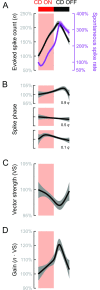Corollary discharge enables proprioception from lateral line sensory feedback
- PMID: 34634044
- PMCID: PMC8530527
- DOI: 10.1371/journal.pbio.3001420
Corollary discharge enables proprioception from lateral line sensory feedback
Abstract
Animals modulate sensory processing in concert with motor actions. Parallel copies of motor signals, called corollary discharge (CD), prepare the nervous system to process the mixture of externally and self-generated (reafferent) feedback that arises during locomotion. Commonly, CD in the peripheral nervous system cancels reafference to protect sensors and the central nervous system from being fatigued and overwhelmed by self-generated feedback. However, cancellation also limits the feedback that contributes to an animal's awareness of its body position and motion within the environment, the sense of proprioception. We propose that, rather than cancellation, CD to the fish lateral line organ restructures reafference to maximize proprioceptive information content. Fishes' undulatory body motions induce reafferent feedback that can encode the body's instantaneous configuration with respect to fluid flows. We combined experimental and computational analyses of swimming biomechanics and hair cell physiology to develop a neuromechanical model of how fish can track peak body curvature, a key signature of axial undulatory locomotion. Without CD, this computation would be challenged by sensory adaptation, typified by decaying sensitivity and phase distortions with respect to an input stimulus. We find that CD interacts synergistically with sensor polarization to sharpen sensitivity along sensors' preferred axes. The sharpening of sensitivity regulates spiking to a narrow interval coinciding with peak reafferent stimulation, which prevents adaptation and homogenizes the otherwise variable sensor output. Our integrative model reveals a vital role of CD for ensuring precise proprioceptive feedback during undulatory locomotion, which we term external proprioception.
Conflict of interest statement
The authors have declared that no competing interests exist.
Figures







Similar articles
-
Early vestibular processing does not discriminate active from passive self-motion if there is a discrepancy between predicted and actual proprioceptive feedback.J Neurophysiol. 2014 Jun 15;111(12):2465-78. doi: 10.1152/jn.00600.2013. Epub 2014 Mar 26. J Neurophysiol. 2014. PMID: 24671531 Free PMC article.
-
Efferent modulation of spontaneous lateral line activity during and after zebrafish motor commands.J Neurophysiol. 2019 Dec 1;122(6):2438-2448. doi: 10.1152/jn.00594.2019. Epub 2019 Oct 23. J Neurophysiol. 2019. PMID: 31642405 Free PMC article.
-
Balancing central control and sensory feedback produces adaptable and robust locomotor patterns in a spiking, neuromechanical model of the salamander spinal cord.PLoS Comput Biol. 2025 Jan 21;21(1):e1012101. doi: 10.1371/journal.pcbi.1012101. eCollection 2025 Jan. PLoS Comput Biol. 2025. PMID: 39836708 Free PMC article.
-
Reafference and the origin of the self in early nervous system evolution.Philos Trans R Soc Lond B Biol Sci. 2021 Mar 29;376(1821):20190764. doi: 10.1098/rstb.2019.0764. Epub 2021 Feb 8. Philos Trans R Soc Lond B Biol Sci. 2021. PMID: 33550954 Free PMC article. Review.
-
Proprioception, the regulator of motor function.BMB Rep. 2021 Aug;54(8):393-402. doi: 10.5483/BMBRep.2021.54.8.052. BMB Rep. 2021. PMID: 34078529 Free PMC article. Review.
Cited by
-
Multisensory navigational strategies of hatchling fish for dispersal.Curr Biol. 2023 Nov 20;33(22):4917-4925.e4. doi: 10.1016/j.cub.2023.09.070. Epub 2023 Oct 20. Curr Biol. 2023. PMID: 37865093 Free PMC article.
-
Whole-body central processing of lateral line inputs encodes flow direction relative to the center-of-mass.bioRxiv [Preprint]. 2025 Jun 17:2025.06.16.659910. doi: 10.1101/2025.06.16.659910. bioRxiv. 2025. PMID: 40666964 Free PMC article. Preprint.
-
Sensorimotor control of swimming Polypterus senegalus is preserved during sensory deprivation conditions across altered environments.J Exp Biol. 2023 May 1;226(9):jeb245192. doi: 10.1242/jeb.245192. Epub 2023 May 10. J Exp Biol. 2023. PMID: 37042272 Free PMC article.
-
Revealing the mechanism and function underlying pairwise temporal coupling in collective motion.Nat Commun. 2024 May 22;15(1):4356. doi: 10.1038/s41467-024-48458-z. Nat Commun. 2024. PMID: 38778073 Free PMC article.
-
Distinctive features of the central synaptic organization of Drosophila larval proprioceptors.Front Neural Circuits. 2023 Jul 26;17:1223334. doi: 10.3389/fncir.2023.1223334. eCollection 2023. Front Neural Circuits. 2023. PMID: 37564629 Free PMC article.
References
-
- Pearson KG. Reflex Reversal in the Walking Systems of Mammals and Arthropods. In: Ferrell WR, Proske U, editors. Neural Control of Movement. Boston, MA: Springer US; 1995. p. 135–141. doi: 10.1007/978-1-4615-1985-0_18 - DOI
Publication types
MeSH terms
Associated data
Grants and funding
LinkOut - more resources
Full Text Sources
Medical

